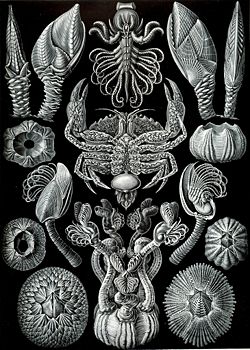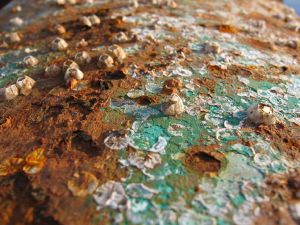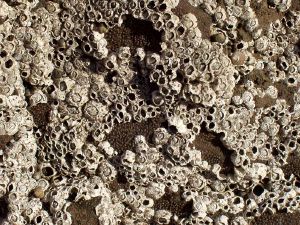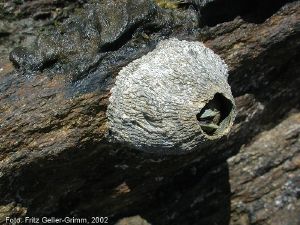Difference between revisions of "Barnacle" - New World Encyclopedia
Katya Swarts (talk | contribs) (Added article and credit tags) |
Katya Swarts (talk | contribs) m |
||
| Line 1: | Line 1: | ||
| − | {{ | + | {{Taxobox_begin | color = pink | name = Barnacle}} |
| − | | color = pink | + | {{Taxobox_image | image = [[Image:Haeckel Cirripedia.jpg|250px]] | caption ="Cirripedia" from [[Ernst Haeckel]]'s ''Artforms of Nature'', 1904. The crab at centre is nursing the externa of a parasitic cirripede of the genus ''[[Sacculina]]''}} |
| − | | name = Barnacle | + | {{Taxobox_begin_placement | color = pink}} |
| − | | image = Haeckel Cirripedia.jpg | + | {{Taxobox_regnum_entry | taxon = [[Animal]]ia}} |
| − | | | + | {{Taxobox_phylum_entry | taxon = [[Arthropoda]]}} |
| − | | | + | {{Taxobox_subphylum_entry | taxon = [[Crustacea]]}} |
| − | | | + | {{Taxobox_classis_entry | taxon = [[Maxillopoda]]}} |
| − | | | + | {{Taxobox_subclassis_entry | taxon = [[Thecostraca]]}} |
| − | | | + | {{Taxobox_infraclassis_entry | taxon = '''Cirripedia'''}}<br/>{{Taxobox authority | author = [[Hermann Burmeister|Burmeister]] | date = 1834}} |
| − | | | + | {{Taxobox_end_placement}} |
| − | | | + | {{Taxobox_section_subdivision | color = pink | plural_taxon = [[Superorder]]s}} |
| − | | | ||
| − | | | ||
| − | | | ||
| − | |||
[[Acrothoracica]]<br/> | [[Acrothoracica]]<br/> | ||
[[Thoracica]]<br/> | [[Thoracica]]<br/> | ||
[[Rhizocephala]] | [[Rhizocephala]] | ||
| − | }} | + | {{Taxobox_end}} |
A '''barnacle''' is a type of [[arthropod]] belonging to [[infraclass (zoology)|infraclass]] '''Cirripedia''' in the [[subphylum]] [[Crustacea]] and is hence distantly related to [[crab]]s and [[lobster]]s. Some authorities regard Cirripedia as a full [[class (biology)|class]] or [[Subclass (biology)|subclass]], and the orders listed at right are sometimes treated as [[superorder]]s. Around 1,220 barnacle [[species]] are currently known. The name "Cirripedia" means "curl-footed". | A '''barnacle''' is a type of [[arthropod]] belonging to [[infraclass (zoology)|infraclass]] '''Cirripedia''' in the [[subphylum]] [[Crustacea]] and is hence distantly related to [[crab]]s and [[lobster]]s. Some authorities regard Cirripedia as a full [[class (biology)|class]] or [[Subclass (biology)|subclass]], and the orders listed at right are sometimes treated as [[superorder]]s. Around 1,220 barnacle [[species]] are currently known. The name "Cirripedia" means "curl-footed". | ||
Revision as of 22:27, 30 June 2006
| Barnacle | ||||||||||||
|---|---|---|---|---|---|---|---|---|---|---|---|---|
 "Cirripedia" from Ernst Haeckel's Artforms of Nature, 1904. The crab at centre is nursing the externa of a parasitic cirripede of the genus Sacculina | ||||||||||||
| Scientific classification | ||||||||||||
| ||||||||||||
| Superorders | ||||||||||||
|
Acrothoracica |
A barnacle is a type of arthropod belonging to infraclass Cirripedia in the subphylum Crustacea and is hence distantly related to crabs and lobsters. Some authorities regard Cirripedia as a full class or subclass, and the orders listed at right are sometimes treated as superorders. Around 1,220 barnacle species are currently known. The name "Cirripedia" means "curl-footed".
Barnacles were first fully studied and classified by Charles Darwin, at the suggestion of his friend Joseph Dalton Hooker, in his quest to further his ongoing development of the theory of evolution and natural selection.
Life cycle
Barnacles have two larval stages. The first is called the nauplius, which spends its time as part of the plankton, floating wherever the wind, waves, currents, and tides may take it, whilst eating and molting. This lasts for about two weeks until the second stage is reached. At this point the nauplius metamorphoses into a non-feeding, more strongly swimming cyprid larva. The cyprids settle down in an area where environmental cues indicate a safe and productive environment. If they don't, the larvae will die.
When an appropriate place is found, the cyprid larva cements itself headfirst to the surface and then undergoes metamorphosis into a juvenile barnacle. Typical barnacles develop six hard armor plates to surround and protect their body. For the rest of their lives they are cemented to the ground, using their feathery legs to capture plankton and gametes when spawning. They are usually found in the intertidal zone.
Like many invertebrates, barnacles are hermaphroditic and alternate male and female roles over time.
Barnacles often attach themselves to man-made structures, sometimes to the structure's detriment. Particularly in the case of ships, they are classified as fouling organisms.
However, some members of the class have quite a different mode of life. For example, members of the genus Sacculina are parasitic on crabs.
The Barnacle Goose gets its name from the ancient European belief that it grew from the gooseneck barnacle, Pollicipes polymerus; eggs and goslings of this bird were never seen because it bred in the remote Arctic. Since barnacles are seafood, the Barnacle Goose was counted as a fish, and could be eaten by Catholics on Fridays, when meat used to be forbidden.
Classification

This article follows Martin and Davis in placing Cirripedia as an infraorder of Thecostraca and in the following classification of cirripedes down to the level of orders:[1]
Infraclass Cirripedia Burmeister, 1834
- Superorder Acrothoracica Gruvel, 1905
- Order Pygophora Berndt, 1907
- Order Apygophora Berndt, 1907
- Superorder Rhizocephala Müller, 1862
- Order Kentrogonida Delage, 1884
- Order Akentrogonida Häfele, 1911
- Superorder Thoracica Darwin, 1854
- Order Pedunculata Lamarck, 1818
- Order Sessilia Lamarck, 1818
Synonyms
Other names for this group of crustaceans include Thyrostraca, Cirrhopoda (meaning "tawny-footed"), Cirrhipoda, and Cirrhipedia.
ReferencesISBN links support NWE through referral fees
- ↑ Joel W. Martin and George E. Davis (2001). An Updated Classification of the Recent Crustacea. Natural History Museum of Los Angeles County.
External links
- Rock barnacle at Aquascope
- Barnacles from the Marine Education Society of Australasia
- http://collections.ic.gc.ca/artifacts/kosapsom/images/barnacle.jpg
- http://www.nhptv.org/natureworks/graphics/barnacle.jpg
- Barnacles in Spain Article on barnacles in Spain, and their collection and gastronomy.
Credits
New World Encyclopedia writers and editors rewrote and completed the Wikipedia article in accordance with New World Encyclopedia standards. This article abides by terms of the Creative Commons CC-by-sa 3.0 License (CC-by-sa), which may be used and disseminated with proper attribution. Credit is due under the terms of this license that can reference both the New World Encyclopedia contributors and the selfless volunteer contributors of the Wikimedia Foundation. To cite this article click here for a list of acceptable citing formats.The history of earlier contributions by wikipedians is accessible to researchers here:
The history of this article since it was imported to New World Encyclopedia:
Note: Some restrictions may apply to use of individual images which are separately licensed.

